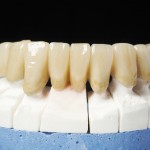
Zirconia is a polycrystalline ceramic without a glassy phase and exists in several forms. Recently, zirconia has been used to fabricate ceramic fixed dental prosthesis FDPs with relatively high strength and good aesthetics. The aim of this systematic review was to assess zirconia-based FDPs in terms of survival and complications. Veneering techniques for porcelain application to zirconia frameworks,either pressing or conventional layering, were also examined.
Only the PubMed database was searched along with reference list of identified articles and only English, peer-reviewed articles of clinical studies included.
12 studies were included ( 1 was a randomised controlled trial, 11 prospective cohorts) and they found
- One study with a 5-year follow-up, three 4-year follow-ups, seven 3-year follow-ups, and one 2-year follow-up.
- Survival rates ranged from 73.9% to 100%.
- Clinical complications included chipping of veneering porcelain, abutment failure, and framework fracture.
- One study investigated pressed ceramics as the veneering material and found no chipping of veneering porcelain after 3 years.
They concluded
Short term clinical data suggest that zirconia-based fixed dental prostheses may serve as an alternative to metal ceramic fixed dental prostheses in the anterior and posterior dentition.
Raigrodski AJ, Hillstead MB, Meng GK, Chung KH. Survival and complications of zirconia-based fixed dental prostheses: A systematic review. J Prosthet Dent.2012 Mar;107(3):170-7. PubMed PMID: 22385693.
Comment
This search for this review only involved the search of a single database and excluded non-English papers. There was also no formal assessment of individual study quality. A number of the studies included participants with one of more FDPs so the impact of clustering should also have been taken into consideration within the initial studies and the review. While participant retention was good in some of the studies there were variable dropout rates across the studies.

[…] Dental Elf 9th March 2012 […]